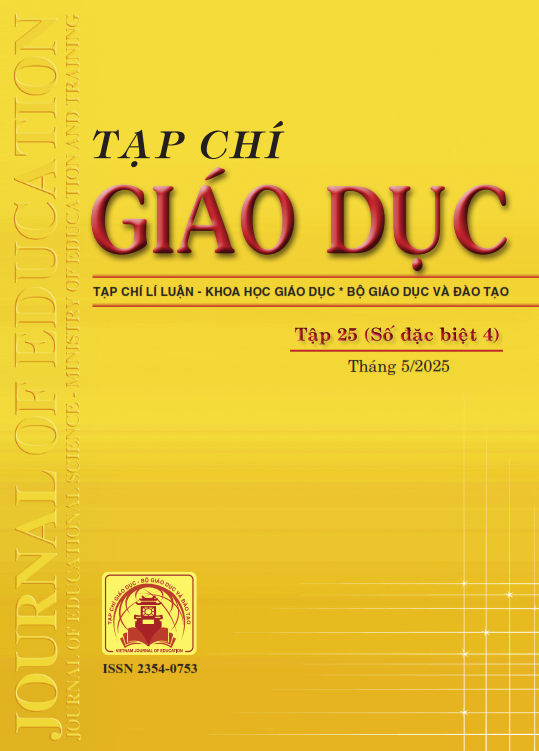Xây dựng thang đo kĩ năng thiết lập mối quan hệ với bạn của trẻ mẫu giáo 4-5 tuổi
Tóm tắt
The skill to establish peer relationships is crucial for preschool children; however, Vietnam lacks suitable assessment instruments to evaluate this skill. This study aimed to develop and initially validate the Vietnamese Peer Relationship Skills Scale (BPRSS-VNs) for 4-5 year-olds children. Through the development and validation process, Exploratory Factor Analysis (N=100) suggested, and Confirmatory Factor Analysis (N=150) confirmed a four-factor structure: (1) Respectful and Effective Communication, (2) Harmonious Cooperation and Sharing, (3) Empathy and Peer Caring, (4) Appropriate Social Conduct. The final 16-item scale demonstrated good internal consistency (Alpha > .90 total, > .77 subscales) and initial construct validity evidence. The BPRSS-VNs shows promise as a culturally relevant tool for research and practice in Vietnam. Despite encouraging initial findings, further validation on larger, diverse samples is essential, including examination of other validity types and establishing norms.
Tài liệu tham khảo
Bandura, A. (1977). Social learning theory. Prentice Hall.
Bierman, K. L. (2004). Peer rejection: Developmental processes and intervention strategies. Guilford Press.
Bộ GD_ĐT (2021). Chương trình giáo dục mầm non (ban hành kèm theo Văn bản hợp nhất số 01/VBHN-BGDĐT ngày 21/4/2024 của Bộ trưởng Bộ GD-ĐT).
CASEL. (2020). CASEL's SEL framework. https://casel.org/sel-framework/
Chen, X. (2010). Culture, peer interaction, and socioemotional development. Child Development Perspectives, 4(1), 27-34. https://doi.org/10.1111/j.1750-8606.2011.00187.x
DeVellis, R. F. (2017). Scale development: Theory and applications (4th ed.). Sage Publications.
Eisenberg, N., Fabes, R. A., và Spinrad, T. L. (2006). Prosocial development. In W. Damon và R. M. Lerner (Series Eds.) & N. Eisenberg (Vol. Ed.), Handbook of child psychology: Vol. 3. (6th ed., pp. 646-718). Wiley.
Fantuzzo, J. W., Coolahan, K. C., Mendez, J. L., McDermott, P. A., & Sutton-Smith, B. (1995). The Penn Interactive Peer Play Scale (PIPPS)... Early Childhood Research Quarterly, 10(1), 1-14.
Gresham, F. M., & Elliott, S. N. (1990). Social Skills Rating System (SSRS). American Guidance Service.
Gresham, F. M., & Elliott, S. N. (2008). Social Skills Improvement System (SSIS) Rating Scales. Pearson Assessments.
Hu, L. T., & Bentler, P. M. (1999). Cutoff criteria for fit indexes in covariance structure analysis: Conventional criteria versus new alternatives. Structural Equation Modeling, 6(1), 1-55. https://doi.org/10.1080/ 10705519909540118
Jones, D. E., Greenberg, M., & Crowley, M. (2015). Early Social-Emotional Functioning and Public Health: The Relationship Between Kindergarten Social Competence and Future Wellness. American Journal of Public Health, 105(11), 2283-2290. https://doi.org/10.2105/AJPH.2015.302630
Ladd, G. W. (2005). Children's peer relations and social competence. Yale University Press.
Lee, S. H., Hong, I., & Park, H. Y. (2022). Development of a Social Play Evaluation Tool for Preschool Children. Healthcare (Basel, Switzerland), 10(1), 102. https://doi.org/10.3390/healthcare10010102
Nunnally, J. C., & Bernstein, I. H. (1994). Psychometric theory (3rd ed.). McGraw-Hill.
Ostrov, J. M., Murray-Close, D., Perry, K. J., Blakely-McClure, S. J., Perhamus, G. R., Mutignani, L. M., … Probst, S. (2023). The development of forms and functions of aggression during early childhood: A temperament-based approach. Development and Psychopathology, 35(2), 941-957. doi:10.1017/S0954579422000177
Parker, J. G., & Asher, S. R. (1987). Peer relations and later personal adjustment: Are low-accepted children at risk? Psychological Bulletin, 102(3), 357-389. https://doi.org/10.1037/0033-2909.102.3.357
Rose-Krasnor, L. (1997). The nature of social competence. Social Development, 6(1), 111-135. https://doi.org/10.1111/j.1467-9507.1997.tb00097.x
Rubin, K. H., Bukowski, W. M., & Laursen, B. (Eds.). (2009). Handbook of peer interactions, relationships, and groups. Guilford Press.
Vygotsky, L. S. (1978). Mind in society: The development of higher psychological processes (M. Cole, V. John-Steiner, S. Scribner, & E. Souberman, Eds. & Trans.). Harvard University Press.
Wentzel, K. R. (2017). Peer relationships, motivation, and academic performance at school. In A. J. Elliot, C. S. Dweck, & D. S. Yeager (Eds.), Handbook of competence and motivation: Theory and application (2nd ed., pp. 586-603). The Guilford Press.
Worthington, R. L., & Whittaker, T. A. (2006). Scale development research: A content analysis and recommendations for best practices. The Counseling Psychologist, 34(6), 806-838.
Đã Xuất bản
Cách trích dẫn
Số
Chuyên mục
Giấy phép

Tác phẩm này được cấp phép theo Ghi nhận tác giả của Creative Commons Giấy phép quốc tế 4.0 .












